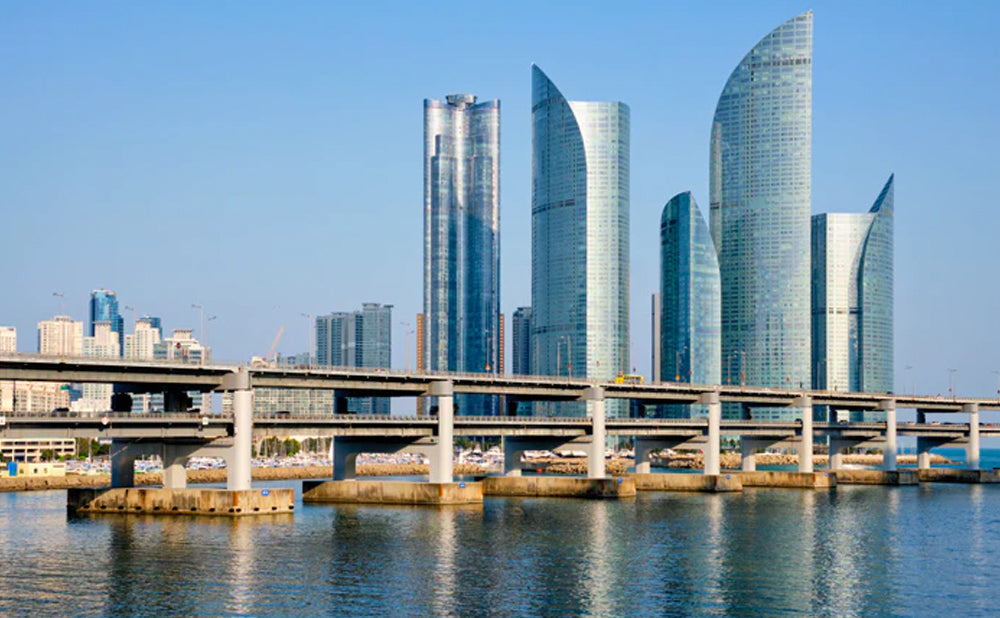How to drive in South Korea?

Basic rules of the roads and driving requirements.
GENERAL TIPS AND ROAD INFORMATION
In South Korea traffic drives on the right and passes on the left side of the road.
Road signs are usually written in both Korean and English, roads are well paved, traffic lights are functional, and most drivers comply with basic traffic laws.
Busy city roads often have a "Bus Only Lane" for the convenience of those who use a public transportation.
Passenger vehicles holding less than six persons are prohibited from using this lane. The "Bus Only Lane" is indicated by a blue line and is usually the far right hand lane.
Left-hand turns are generally prohibited except where a green arrow indicates otherwise. Drivers may turn right on a red light after coming to a complete stop.
People driving in the Republic of Korea may wish to carry a disposable camera to document any traffic accidents, even minor ones.
Roads and Motorways
Over half of the roads are paved. Excellent motorways link all major cities, but minor roads are often badly maintained.
Arterial routes have two digit route numbers, with north-south routes having odd numbers, and east-west routes having even numbers. Primary routes have five and zero as their last digits respectively, while lesser routes have last digits other than five and zero.
Branch routes have three digit route numbers, where the first two digits match that the route number of an arterial route.
Belt lines have three digit route numbers where the first digit matches the respective city's postal code.
Route number range 70-99 are reserved in the event of Korean reunification.
The Gyeongbu Expressway kept the route 1 moniker, as it is South Korea's first and most important expressway.
Highways in South Korea are classified into highways (expressways/motorways), national highways, and various classifications below the national level. South Korea has about 3,000 kilometers of national highways.
Parking
Parking is a serious problem in Korea. In Seoul, for example, there are simply too many automobiles. The streets are too narrow and parking spaces are very scarce.

Fines
Under Korean law, anyone who drives an automobile is considered a "professional" driver and is held to a very high standard of duty to prevent accidents. The Road Traffic Law provides penalties for violating these standards. These penalties range from a small fine to imprisonment. Anyone who violates any of the rules and causes damage to property of another is subject to a penalty under that law. Anyone who breaches the duty of care and causes the death or injury of another may be charged with "occupational negligence resulting in death or injury" under the ROK Criminal Code.
Driving under the influence of alcohol or drugs is a serious offence. Korean police are extremely adept at placing breath-test roadblocks at locations that are impossible to avoid once you can see them. Refusal to take the breath-test will result in cancellation of your license. You are legally drunk in Korea when you have a blood-alcohol level of 0.05% or higher. Driving while intoxicated can result in anywhere from your license being suspended for 100 days to being cancelled altogether, and well as you being issued a hefty fine.
Fuel
Gasoline prices in South Korea are high, because the country needs to import all its oil.
SPEED LIMITS
Speed limits are not posted but are generally around 60 miles per hour (100 kilometers per hour) on expressways; 50 miles per hour (80 kilometers per hour) on highways; 40 miles per hour (60 kilometers per hour) on rural roads; and 30 miles per hour (50 kilometers per hour) in urban areas.

TOLL INFORMATION
Korea Highway Corporation operates the toll highways and service amenities in routes.
DRIVING REQUIREMENTS
The minimum legal age to drive automobiles in the Republic of Korea is 18 and 16 for motorbikes.
Drivers Licence
International Driving Licence (IDL) is required for foreigners to drive in South Korea. Drivers must have more than one year’s driving experience, be in possession of a valid passport and be over 25 years of age.
International Driving Licence is required for short-term visitors who drive in the Republic of Korea. Otherwise, drivers must have a Korean driver's license.
Insurance
Insurance is mandatory for all cars but not for motorcycles. In Korea, if an accident occurs, the party at fault is responsible for damages, including medical costs if anyone is injured. If the party at fault has insurance, they will only have to pay a portion of the repair and medical costs. However, if the party at fault does not have insurance, they could stand to lose a considerable amount of money. With insurance, repair and injury costs are set by the insurance companies, and accident victims can only claim a pre-determined amount, both for vehicle repairs and for injuries. However, if the party at fault has no insurance, victims can seeks the costliest repair facilities and hospitals, with nearly no limit on what damages they can seek. Insurance is fairly cheap and only gets cheaper each year that you go without an accident and can be easily purchased from one of many insuruance companies or even at a local post office, so it is extremely prudent for anyone driving any kind of vehicle in Korea to purchase a policy.
Seatbelts
Seat belts are mandatory and violators will receive a fine.
Children
Children riding in the front seat of vehicles must wear a seat belt or use an appropriate child car seat.
Motorcycles
Passengers on motorcycles must wear protective helmets.
USEFUL TELEPHONE NUMBERS
Police 112
Fire & Emergency 119/129
Sources: iExplore.com / U.S. Department of State / Tour 2 Korea / Wikitravel / Wikipedia / PlanetEsl
